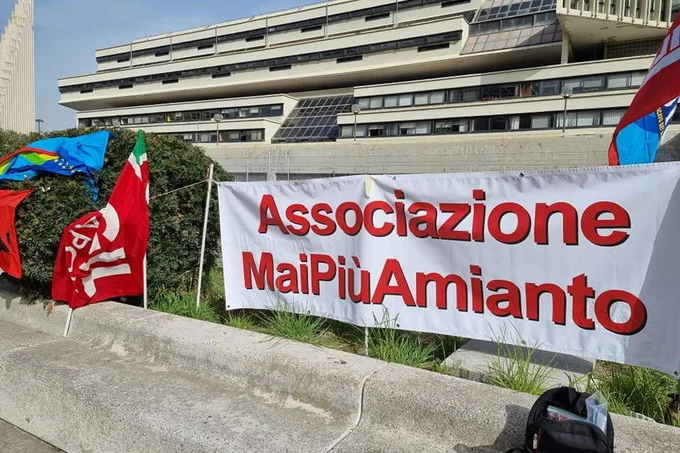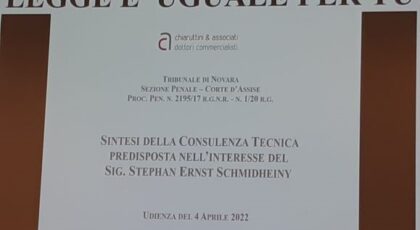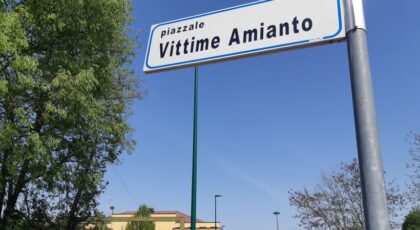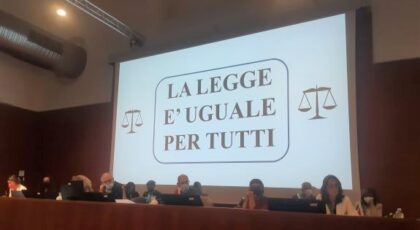SILVANA MOSSANO
La Corte d’Assise di Napoli ha condannato Stephan Schmidheiny a 3 anni e 6 mesi di reclusione riconoscendolo responsabile della morte causata dall’amianto di una delle otto vittime – Antonio Balestrieri – indicate nel capo di imputazione. Il reato è stato riqualificato da doloso in colposo.
«In nome del Popolo italiano la Corte d’Assise di Napoli, sezione II, all’udienza del 6 aprile 2022 ha pronunciato la seguente sentenza nei confronti di Schmidheiny Stephan Ernst, nato il 29 ottobre 1947»: il dispositivo è stato letto, poco prima delle 16, dalla presidente Concetta Cristiano. Erano presenti i difensori storici dell’imputato svizzero Astolfo Di Amato e Guido Carlo Alleva e, tra i legali delle parti civili, l’avvocato Laura D’Amico, che rappresenta l’Afeva (Associazione famigliari e vittime amianto) di Casale, stesso ruolo di tutela che assolve nel processo Eternit Bis che si celebra in Corte d’Assise a Novara per 392 morti d’amianto monferrini.
Le pm di Napoli Anna Frasca e Giuliana Giuliano, in requisitoria, avevano insistito per il riconoscimento dell’omicidio volontario chiedendo la condanna a 23 anni e 11 mesi per tutti gli 8 casi (6 dipendenti dello stabilimento Eternit di Bagnoli e 2 loro famigliari) indicati nel capo di imputazione. I difensori, a loro volta, si erano battuti per l’assoluzione, sostenendo che Schmidheniy aveva fatto di tutto per rendere l’ambiente lavorativo nello stabilimento di Bagnoli conforme alle norme.
La Corte d’Assise ha invece affermato la responsabilità dell’imputato, riconoscendo che le condizioni di lavoro erano in difetto, ma non ha ritenuto che la sua condotta sia stata indotta da dolo eventuale, bensì da colpa cosciente.
La riqualificazione del reato da doloso in colposo (pur, appunto, con l’aggravante della colpa cosciente) ha fatto scattare automaticamente la prescrizione per 6 casi; per un altro è stata pronunciata l’assoluzione «perché il fatto non sussiste» (il perché si conoscerà nelle motivazioni della sentenza, preannunciate entro 90 giorni). La condanna a 3 anni e mezzo si riferisce, dunque, a un caso di morte.
«Il verdetto napoletano è in linea con quello torinese per i due morti di Cavagnolo» osserva l’avvocato D’Amico. Quindi: «La Corte ha accertato e affermato la responsabilità di Schmidheiny in ordine alle compromesse condizioni ambientali all’Eternit di Bagnoli, ma con riconoscimento a titolo di colpa cosciente e non di dolo eventuale». Il verdetto prevede anche l’interdizione dai pubblici uffici per 5 anni dell’imputato oltre ai danni da risarcire alle parti civili tra cui enti e associazioni.
Il processo Eternit Bis, promosso dalla procura di Torino nel 2014, con la contestazione del reato di omicidio volontario in capo all’imprenditore svizzero, era stato poi «spacchettato» dal gup di Torino: sono già andati a sentenza i filoni di Cavagnolo (dove Schmidheiny è stato condannato a 4 anni, confermati in Appello a inizio marzo 2022) e ora di Napoli (in primo grado). E’ in corso di svolgimento il filone più corposo, che si celebra davanti alla Corte d’Assise di Novara: la contestazione sostenuta dai pm Gianfranco Colace e Mariagiovanna Compare è di omicidio volontario di 392 vittime dell’amianto nel Casalese.
La riqualificazione del reato a Napoli per i morti di Bagnoli, come era già avvenuto a Torino per quelli di Cavagnolo (in quel caso attuata dal gup), potrebbe far pensare a una strada segnata anche per il «filone Casale»?
Certamente il frazionamento del fascicolo originario aveva creato fin da subito perplessità, perché si tratta di giudicare morti causate dalla diffusione di amianto contestate allo stesso imputato. Tuttavia, a Casale emergono situazioni specifiche di responsabilità che, negli altri due siti, non c’erano, o non sono emerse.
Un esempio: la frantumazione di rottami di eternit a cielo aperto, nell’area cosiddetta Ex Piemontese, al Ronzone, a poche centinaia di metri dallo stabilimento, decisa e svolta proprio nel periodo in cui gestore dell’Eternit era Schmidheiny. E’ l’attività della ruspa, più volte evocata da testimoni, che proseguiva per ore e ore al giorno, sollevando nuvole di polvere tra le case. I rottami sminuzzati venivano poi trasportati su «camionette» dalla piazzola allo stabilimento, lungo via Oggero, per essere convogliati nel mulino Hazemag e reimmessi nel ciclo produttivo. I sindacati avevano fatto battaglie per contenere quella dispersione: «Almeno coprite le camionette durante il trasporto!».
A Napoli la frantumazione non si faceva. Come mai? Perché i rottami di risulta provenienti da Bagnoli venivano portati a Casale, si faceva tutto all’ex Piemontese.
Altro esempio: la distribuzione del polverino (contenente la crocidolite o amianto blu), al di fuori dalla fabbrica, con cui furono coibentati sottotetti, e livellati cortili, campetti sportivi, strade. A Casale e dintorni si è trovato in molti siti, ed è il più pericoloso.
Sono soltanto puntualizzazioni e riflessioni, a margine del processo in corso. Sull’esito, è prematura e incauta ogni previsione.
A Novara attualmente le difese stanno esaminando i loro esperti che propongono tesi contrapposte a quelle già illustrate dai consulenti della procura. Il confronto, ovviamente, è serrato su aspetti societari, igienico-sanitari, clinici, epidemiologici.
Se il programma di massima sarà rispettato, come spera il presidente della Corte Gianfranco Pezone, entro la fine di luglio si potrebbe chiudere la fase dibattimentale, per fissare a settembre l’avvio della discussione, con attesa di sentenza in autunno.
Translation by Vicky Franzinetti
NAPLES TRIAL
SILVANA MOSSANO
The Court of Assizes of Naples sentenced Stephan Schmidheiny to 3 years and 6 months of imprisonment for the death caused by asbestos of one of the eight victims – Antonio Balestrieri. The crime was reclassed as manslaughter (omicidio colposo con colpa cosciente).
“In the name of the Italian people, on April the 6th 2022 the Court of Assizes of Naples, Circuit 2, issued the following sentence against Schmidheiny Stephan Ernst, born on October 29, 1947″: the main judge President Concetta Cristiano read the ruling shortly before 4 p.m., The Swiss defendant’s lawyers Astolfo Di Amato and Guido Carlo Alleva attended as did lawyer Laura D’Amico, who represents Afeva (Association of families and asbestos victims) of Casale, which she also does in the Court of Assizes in Novara for 392 dead of asbestos [move word to follow Casale in this sentence Monferrato].
In their indictment, the Public Prosecutors of Naples, Anna Frasca and Giuliana Giuliano, had insisted on the recognition of willful murder, asking for a sentence of 23 years and 11 months for all 8 cases (6 employees of the Eternit plant of Bagnoli and 2 of their relatives). The defense team had [delete instead] fought for the acquittal, arguing that Schmidheniy had done everything to make the working environment in the Bagnoli plant compliant with regulations.
The Assize Court, on the other hand, recognized the responsibility of the defendant, ruling that working conditions were lacking, but did not consider that his behavior was due to malice aforethought, but rather by willful negligence due to intentional misconduct (colpa cosciente).
The redefinition of the crime from intentional to culpable (albeit with the aggravating circumstance of willful negligence) automatically triggered the statute of limitations for 6 cases; in another case SS was acquitted “because there is no case” (the Court’s motivations will be known in the motivations of the sentence, in 90 days). The sentence of 3 and a half years refers, therefore, for one death.
“The Neapolitan verdict is in line with the Turin verdict for the two deaths in Cavagnolo” observes lawyer D’Amico. Therefore: “The Court has ascertained and affirmed Schmidheiny’s responsibility for the compromised environmental conditions at the Eternit plant in Bagnoli, but with recognition of intentional misconduct and not of willful murder”. The verdict also states the defendant is banned from any public office for 5 years in addition to the costs to be paid to the plaintiffs including institutions and associations. [will such costs be assessed in this case by the Court of Assizes or any other court?]
The so-called Eternit Bis case was initiated by the Turin Prosecutor’s Office in 2014, with the charge of willful murder against the Swiss entrepreneur, was then subdivided by the Turin Judge of the Preliminary Hearing (aka GUP): Cavagnolo (where Schmidheiny was sentenced to 4 years, confirmed in the Court of Appeal at the beginning of March 2022) and now Naples. The largest case, which is being heard before the Court of Assizes of Novara, is underway: the charge by the Public Prosecutors, Gianfranco Colace and Mariagiovanna Compare, is that of willful murder of 392 victims of asbestos in the Casale area.
Could the Naples verdict for the deaths of Bagnoli, as had already happened in Turin for those of Cavagnolo lead to [delete think of] a marked path also for the “Casale case”?
Certainly, the splitting of trials created perplexity from the beginning, because the same defendant had the same behavior in all cases. However, in Casale specific situations of responsibility emerge which, in the other two sites, were missing, or did not emerge.
An example: the crushing of asbestos scrap in the open, in the so-called Ex Piemontese area, at Ronzone, a few hundred meters from the plant, decided and carried out during the period in which Schmidheiny was the manager of Eternit. It is the activity of the bulldozer, repeatedly evoked by witnesses, which went on for hours and hours a day, raising clouds of dust among the houses. The shredded debris was then transported on “trucks” from the yard to the plant, along Via Oggero, to be conveyed to the Hazemag mill and put back into the production cycle. The unions had fought to limit the spread: “At least cover the trucks during transport!” they had repeatedly asked.
There was no crushing in Naples. How come? Because the scrap from Bagnoli was taken to Casale, and everything was processed at the former Piedmontese plant.
Another example: the distribution of dust (containing crocidolite or blue asbestos), outside the factory, with which attics were insulated and courtyards, sports fields and roads were levelled. In Casale and its surroundings had many such sites, and it is the most dangerous.
These are just remarks, on the sidelines of the ongoing trial. It is premature and unwise to predict the outcome.
At the moment in the Novara trial the defense lawyers are examining their experts who are opposing the theses illustrated by the PP’s expert witnesses. The comparison, obviously, is focused on societal, hygienic-health, clinical and epidemiological aspects.
If the outlined dates will be respected, as the president of the Court Gianfranco Pezone hopes, by the end of July the trial phase could be over, setting the beginning of the closing arguments in September with a verdict before Autumn is over.





Uno spiraglio di luce. Potrebbe diventare un faro gigante. Come sempre grazie per le dettagliate informazioni.
Grande informazione stai facendo cara Silvana. Brava e grazie . Paolo